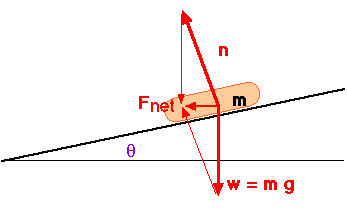
(http://www.trackplanning.com/superelevation.htm)
Banked Curves
Superelevation refers to cross slope introduced into the cross section of a roadway in order to compensate for the centrifugal forces created by horizontal curves. A track is said to be superelevated when one rail is higher than the other through a curve. Raising one rail tilts the train as it passes over, banking it into the turn much like an airplane. This allows the train to transit the curve at higher speeds and greater comfort than possible without superelevation.
But it is more interesting to see the reaction on a highway setting with
a banked curve.
How can a car ever travel at all on a slippery highway? Some curves are
banked to compensate for slippery conditions like ice on a highway or
oil on a racetrack. Below is a car making a banked turn. Without friction,
the roadway still exerts a normal force n perpendicular to its surface.
And the downward force of the weight w is present. Those two forces add
as vectors to provide a resultant or net force Fnet which points toward
the center of the circle; this is the centripetal force. Note that it
points to the center of the circle; it is not parallel to the banked roadway.

(http://oldsci.eiu.edu/physics/DDavis/1150/05UCMGrav/Curve.html)